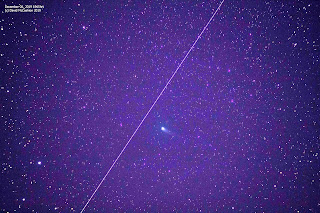Location: Front deck, Little Lepreau, NB, Canada
Date Time: September 19, 2019 2130-2315 hrs
Weather: Cool, mostly clear to partly cloudy, no wind to slight breeze, no bugs, no dew, 6C, and 75% humidity. One of the nicest nights of the year, temperature wise, for observing.
Equipment: Canadian Telescopes 80 ED/APO on motorized, tracking mount, 19mm eyepiece, Canon Rebel T3 with 18-55mm lens and attached to telescope at prime focus, 8" Meade telescope with 19mm and 32 mm eyepieces. Images stacked with DeepSkyStacker and processed with Photoshop.
Attendance: David McCashion
Objective: To view and image
Comet C/2018 W2 Africano, which was reported to be just above, and to the right of Mirach, in Andromeda.
Report:
- Set up scopes on deck, around 2145hrs, and aligned small scope on Jupiter, Saturn, in the South west, and on Mirach, high in the East.
- Was able to find Comet Africano by imaging the area around Mirach. Took 13 minutes worth of images of the comet, and the comet moved during those 13 mins, which showed up in the images. the comet moved in relation to the background stars, as the telescope tracked the stars, not the comet.
 |
| Single, 10 second image. 6400 ISO, focal length 40mm, f/5.6 |
 |
| Single, 2 minute exposure, ISO 6400. Heavily processed to bring out more comet detail. |
 |
| 14 images stacked, 45 Second, ISO 6400. Shows 13 minute path of comet. |
- Searched for the comet with the bigger 8" telescope with the 19mm and 32mm eyepieces, but couldn't confirm a sighting. Moonlight and haze were factors.
- After 2230hrs, the moon started to rise, and some hazy conditions started, including some clouds.
 |
| Single, 4 second image, 6400 ISO, f/5.6, focal length 40mm. Showing brightness of the waning gibbous moon. |
- No shooting stars and a few satellites were seen.
- By 2300hrs, Moon, which was in the waning gibbous phase, was so bright, it washed out any chance of observing the very faint, diffuse comet.















































